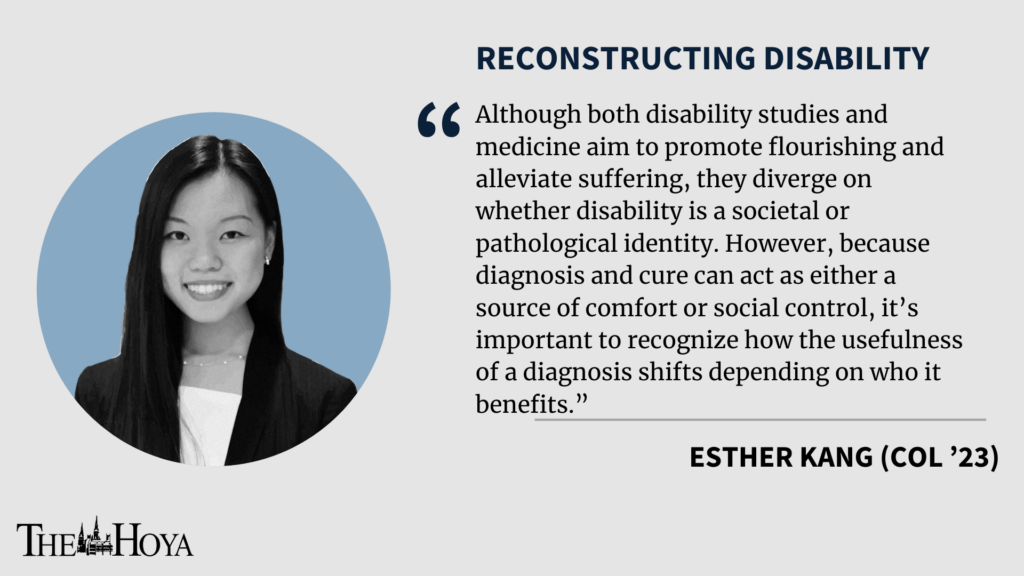Although both disability studies and medicine aim to promote flourishing and alleviate suffering, they diverge on whether disability is a societal or pathological identity. However, because diagnosis and cure can act as either a source of comfort or social control, it’s important to recognize how the usefulness of a diagnosis shifts depending on who it benefits.
For a while, I was disturbed by the apparent contradiction between the philosophies behind DS and my pre-medical path. Whereas DS sees disability as the product of society’s subjective definitions of health, medicine perceives disability as a problem confined to an individual person’s physiology.
Considering that the assumed authority of diagnoses has been responsible for the systematic isolation of and violence against countless groups, it seemed like the next plan of action was to join the movement of tearing down barriers and confronting ableist systems for the ways they devalue vulnerability and interdependence. I didn’t want to enable the medical-industrial complex, concede that disability is a matter of pathology and contribute to the viewpoint that some bodies and minds are “better off dead than disabled.”
The act of diagnosing a patient takes for granted that all disabilities are undesirable and should therefore be cured, or at least prevented. To be “cured” of disability means eradicating its existence in the future, once and for all. In his memoir, “Brilliant Imperfection,” author Eli Clare writes that he cannot conceive a version of himself without cerebral palsy; to be cured of it would completely erase his identity. Diagnosis here obscures much of what we know about each other, prioritizing an objective medical history over the personal history that can develop from someone’s physical and mental complications.
In this model of disability, where medicine is positioned as the antagonist, there’s little room for stories about chronic pain or surviving cancer and other terminal illnesses. It’s true that with diagnosis, there can be relief in knowing there is a name, history and group of people who live a similar reality. For some, diagnosis means their pain is no longer a formless entity, but a real condition. For others, the possibility of a cure for their condition can serve as a powerful source of hope.
We see there are two contradictory realities, where the desire for cure can either save or destroy a person’s sense of self. Usually, when we learn of a cure on the horizon, we read that news as hopeful, as the end of pain, suffering and death. However, in Clare’s case, being “cured” of CP means erasing the intimacy he has with his body that he now celebrates and sees as a source of art and poetry. At the Judge Rotenberg Educational Center, parents of disabled children also justify the continued operation of the institution as the only “cure” for their children’s diagnosed conditions.
This raises the question of whether we can rethink disability without rejecting people’s desires for cure. To this end, Clare suggests we rework our contradictory relationship with cures and the body through the perspective of environmental politics.
Earth is no longer a nonpolitical body whose narrative can be extricated from human society, its compromised health being the direct consequence of modern civilization. Depoliticizing climate change is akin to depoliticizing disability. That is, the way we conceive of our own well-being and restoration depends on whether we place the burden for change on individual bodies or the cultures that exclude them.
Diagnosis is not just a tool for discovering objective information about a patient’s health. It grants the parents of children with disabilities, children with disabled parents and institutions the power to control someone’s future in the name of cure. It also has the power to bring profound peace to an person’s relationship with their body. That said, the questions we should be led to ask are not whether diagnosis is good or bad, but who desires it, for what ends and how high the cost for cure that it envisions will be raised.
Esther Kang is a sophomore in the College. Reconstructing Disability appears online every other Saturday.









